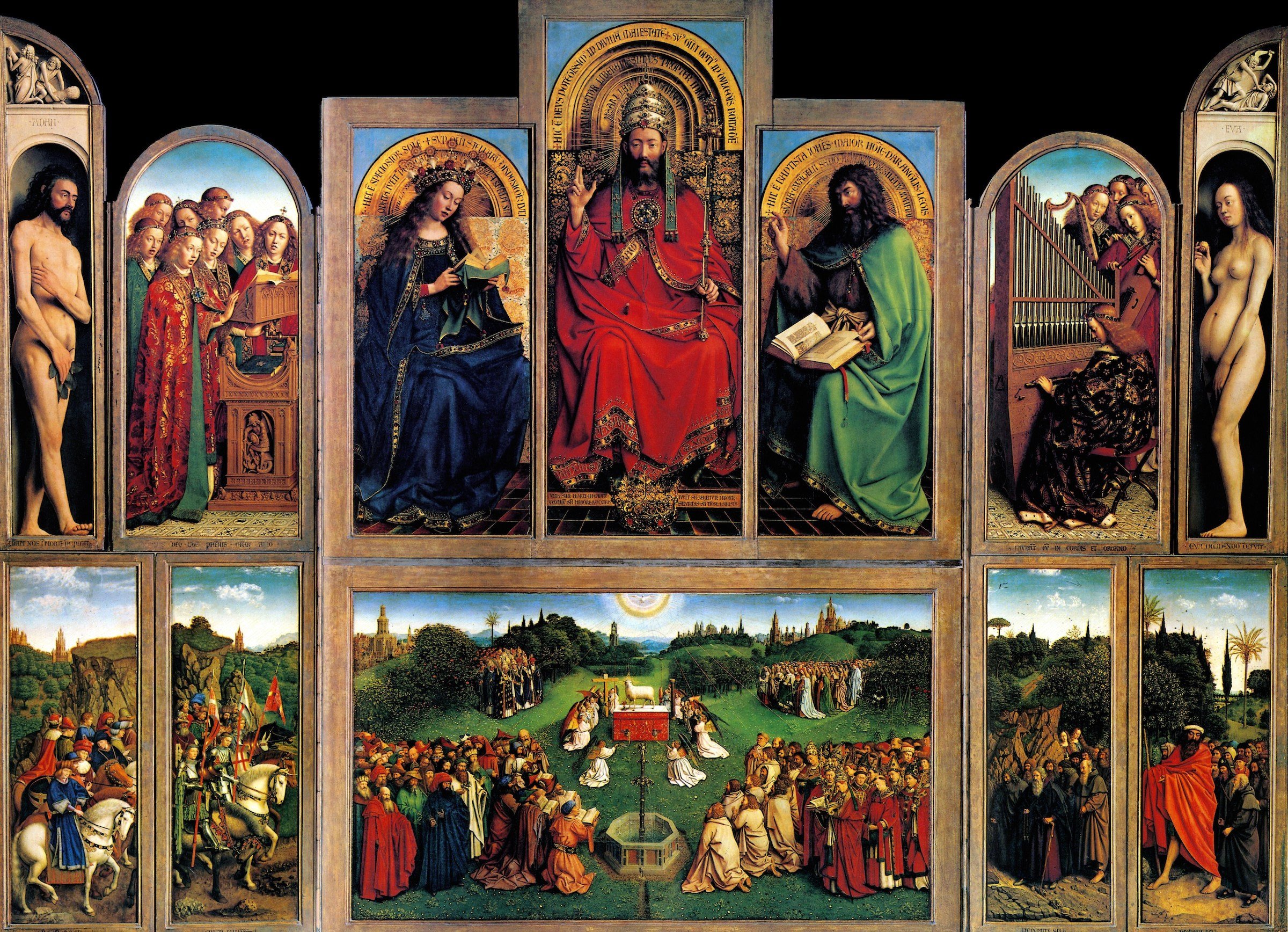
No painting in history has endured trials and tribulations quite like the Adoration of the Mystic Lamb. Since its completion in 1432, Flemish painter Jan Van Eyck’s masterpiece has been victim to burning, dismemberment, rampaging Calvinists, censorship, a surreptitious sale by a renegade vicar, theft by Napoleon, and even looting by Nazis who believed the painting held occult secrets.
The Ghent Altarpiece, as it is commonly known, is regarded by experts as possibly the most important artwork of all time. It is considered history’s first great oil painting and the seminal panel painting of the Renaissance. It was an artifact of pilgrimage for creatives and thinkers of its era, and remains so today.
The monumental polyptych is composed of twelve hinged panels and weighs over two tons. It is currently on display at its original home, the cathedral of Saint Bavo in Ghent, Belgium. The painting depicts the saga of Christianity: the panels portray Adam and Eve, singing angels, the Virgin Mary enthroned, the Annunciation, and the symbolic sacrifice of Christ, with the central panel illustrating the “Mystic Lamb” bleeding into the Holy Grail atop an altar in a sacred meadow.
It is also considered the most stolen artwork of all time, having been snatched up, all or in part, no less than six times. One heist remains unsolved today, with an on-duty detective at Ghent’s police station assigned specifically to the case. On April 10th, 1934, the double-sided panel known as the Just Judges was stolen from the cathedral in the dark of night. Soon after, a ransom note demanding one million Belgian francs appeared in the Bishop’s mail. As a sign of good faith, the thief left the separated backside of the panel, a grisaille painting of Saint John the Baptist, at the checked-luggage department of the Ghent train station. The Belgian government refused to pay.
Copy of the Just Judges panel by Jef Van der Veken.
Eleven more ransom notes followed in negotiation until November of the same year, when a stockbroker named Arsène Goedertier collapsed in cardiac arrest at a Catholic political rally. That night, he summoned his lawyer for a secret 15-minute meeting where Goedertier allegedly whispered, with his literal dying breath, that he was the only man who knew the location of the panel. He directed his lawyer to a drawer with carbon copies of the ransom notes and a 13th unreleased letter that held a clue: “[it] rests in a place where neither I, nor anybody else, can take it away without arousing the attention of the public.”
Amateur detectives and sleuths continue to search for the painting, with the police station receiving and investigating several tips every year. The entire cathedral underwent an x-ray scan in search of the panel that turned up nothing. Notably, during World War II, Third Reich Minister of Propaganda Joseph Goebbels sent a Nazi art detective to find the panel, intending to gift it to Hitler for his birthday. In 2018, A pair of Belgian writers held a press conference at Ghent’s City Hall where they posited that the panel is buried under Kalandeberg Square, a shopping district in the center of town.
Today, The Ghent Altarpiece is on display with the 11 original panels alongside a replacement copy of the Just Judges panel painted by Jef van der Veken, an art conservator who moonlit as a forger. He worked on his duplication from 1939 until it was purchased by the Belgian government in 1957. Sleuths find it suspicious that van der Veken decided to make the replacement on his own accord, without request from the church, and signed the back with a cryptic poem:
I did it for love
And for duty
And to avenge myself
I borrowed
From the dark side.
The Hunt explores art and ancient relics that are—alas!—lost to time. From the Ark of the Covenant to Cleopatra’s tomb, these legendary treasures have long captured the imaginations of historians and archaeologists, even if they remain buried under layers of sand, stone, and history.